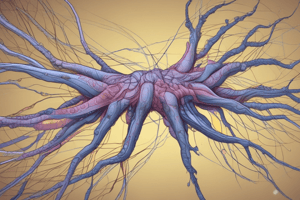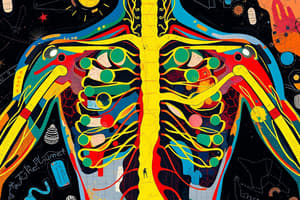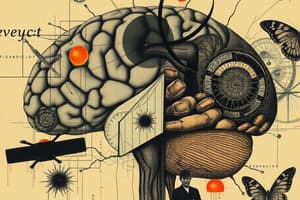Podcast
Questions and Answers
What is the primary function of the cerebrospinal fluid (CSF)?
What is the primary function of the cerebrospinal fluid (CSF)?
- To generate neurotransmitters for communication
- To increase the weight of the brain within the skull
- To act as a shock absorber and prevent brain injury (correct)
- To transport nutrients to nerve cells
In the brain, where is the white matter located compared to the gray matter?
In the brain, where is the white matter located compared to the gray matter?
- Inner part of the brain (correct)
- Distributed evenly throughout the brain
- Only in the brainstem
- Outer part of the brain
Which structure surrounds the brain and spinal cord, providing protection?
Which structure surrounds the brain and spinal cord, providing protection?
- Meninges (correct)
- Cerebrospinal fluid (CSF)
- Neuroglia
- White matter
What characterizes the arrangement of gray and white matter in the spinal cord?
What characterizes the arrangement of gray and white matter in the spinal cord?
What is the significance of the blood-brain barrier?
What is the significance of the blood-brain barrier?
What type of neuron carries sensory impulses from the periphery to the central nervous system?
What type of neuron carries sensory impulses from the periphery to the central nervous system?
Which type of synapse involves the axon of a presynaptic neuron ending on the soma of a postsynaptic neuron?
Which type of synapse involves the axon of a presynaptic neuron ending on the soma of a postsynaptic neuron?
What is the primary function of motor neurons?
What is the primary function of motor neurons?
Which classification of synapse allows for direct ionic exchange between neurons?
Which classification of synapse allows for direct ionic exchange between neurons?
Which component is NOT part of the anatomical classification of synapses?
Which component is NOT part of the anatomical classification of synapses?
What is the primary site of formation for cerebrospinal fluid (CSF)?
What is the primary site of formation for cerebrospinal fluid (CSF)?
Which of the following substances can pass through the blood-brain barrier (BBB)?
Which of the following substances can pass through the blood-brain barrier (BBB)?
What is a significant difference between cerebrospinal fluid (CSF) and blood?
What is a significant difference between cerebrospinal fluid (CSF) and blood?
What role does the blood-brain barrier (BBB) serve in the brain?
What role does the blood-brain barrier (BBB) serve in the brain?
Which of the following statements about the blood-brain barrier (BBB) is true?
Which of the following statements about the blood-brain barrier (BBB) is true?
Flashcards
Chemical Synapse
Chemical Synapse
Specialized junctions between two neurons, allowing communication through the release of chemical messengers called neurotransmitters.
Axodendritic Synapse
Axodendritic Synapse
A type of synapse where the axon of one neuron ends on the dendrite of another neuron.
Axosomatic Synapse
Axosomatic Synapse
A type of synapse where the axon of one neuron ends on the cell body (soma) of another neuron.
Sensory Neuron
Sensory Neuron
Signup and view all the flashcards
Motor Neuron
Motor Neuron
Signup and view all the flashcards
Cerebrospinal Fluid (CSF)
Cerebrospinal Fluid (CSF)
Signup and view all the flashcards
Blood-Brain Barrier (BBB)
Blood-Brain Barrier (BBB)
Signup and view all the flashcards
Trypan Blue
Trypan Blue
Signup and view all the flashcards
Concentration Gradients
Concentration Gradients
Signup and view all the flashcards
Lipid-Soluble Drugs
Lipid-Soluble Drugs
Signup and view all the flashcards
Synaptic Cleft
Synaptic Cleft
Signup and view all the flashcards
Neurotransmitter
Neurotransmitter
Signup and view all the flashcards
Meninges
Meninges
Signup and view all the flashcards
Blood-Brain Barrier
Blood-Brain Barrier
Signup and view all the flashcards
Study Notes
Nervous System Overview
- The nervous system is comprised of neurons and neuroglia
- Structures of the brain and spinal cord are arranged in two layers
- Gray matter is composed of nerve cell bodies and proximal parts of nerve fibers arising from nerve cell bodies.
- White matter is composed of the remaining parts of nerve fibers
Nervous System Classification
- Anatomical classification: based on the structures of the brain, spinal cord, and peripheral nerves
- Functional classification: based on the function of the system, somatic and autonomic systems.
Nervous System Components
- Central Nervous System (CNS): includes the brain and spinal cord
- Brain: is subdivided into the cerebral cortex, cerebellum, brain stem and others
- Spinal cord: extends from the foramen magnum to the vertebral column
- Peripheral Nervous System (PNS): consists of cranial nerves and spinal nerves, divided into
- Somatic nervous system
- Autonomic nervous system: includes sympathetic and parasympathetic nervous systems
Synapse
- Synapse is the junction between two neurons
- It is not an anatomical continuation, only a physiological continuity
- Anatomical classification methods include:
- Axoaxonic synapse: axon of presynaptic neuron ends on axon of postsynaptic neuron
- Axodendritic synapse: axon of presynaptic neuron connects with dendrite of postsynaptic neuron
- Axosomatic synapse: axon of presynaptic neuron ends on the soma (cell body) of postsynaptic neuron
- Functional classification
- Electrical synapse: the physiological continuity between both neurons is provided by gap junctions.
- Chemical synapse: neurotransmitter is released from one neuron, crosses the synaptic cleft. and triggers a response in the postsynaptic neuron.
Protection and Nourishment of the Brain
- Central nervous tissue is delicate
- Encased by hard, bony structures (cranium and vertebral column)
- Protected by meninges (three layers):
- Dura mater
- Arachnoid mater
- Pia mater
- Surrounded by cerebrospinal fluid (CSF) a cushioning fluid
- Blood-brain barrier (BBB) selective limits substances entering the brain from the blood stream
Cerebrospinal Fluid (CSF)
- CSF surrounds the brain and spinal cord
- Acts as a shock absorber against mechanical injury
- Facilitates the exchange of materials between neural cells and interstitial fluid
- CSF differs in composition from blood
Blood-Brain Barrier (BBB)
- Neuroprotective structure that prevents entry of many substances and pathogens into the brain tissues from blood
- Exists in capillary membrane of all parts of the brain, except some areas of hypothalamus.
Functions of the Blood-Brain Barrier (BBB)
- Acts as a mechanical barrier and transport mechanisms
- Prevents potentially harmful chemical substances from entering the brain tissue
- Permits entry of essential materials
- BBB provides a healthy environment for nerve cells
Reflex Activity
- Reflex activity is the nervous systems response to stimulation that occurs without consciousness.
- Reflex arc is the anatomical nervous pathway for a reflex action, consisting of: Stimulus, Receptor, Afferent Nerve, Center, Efferent Nerve, Effector Organ
CNS Functional Levels
- Three major levels with specific functional characteristics:
- Spinal cord level: responsible for walking movements, reflexes, and control of local blood vessels
- Lower brain or subcortical level: responsible for control of subconscious activities, such as arterial pressure, respiration, equilibrium cerebellum
- Higher brain or cortical level, including the cerebral cortex, responsible converting the functions of lower brain centers into definitive operations including memory, intelligence, and higher functions
Studying That Suits You
Use AI to generate personalized quizzes and flashcards to suit your learning preferences.




